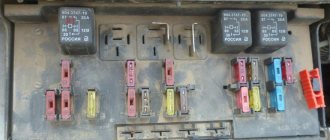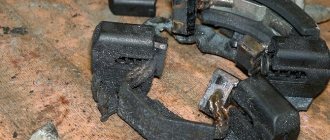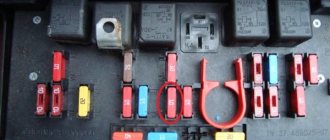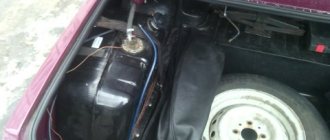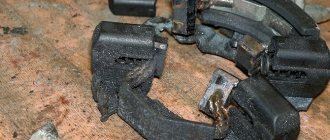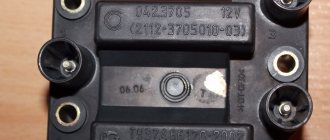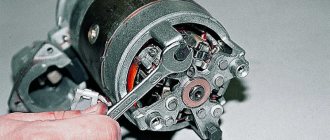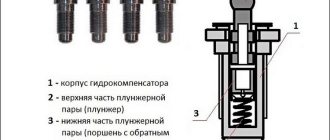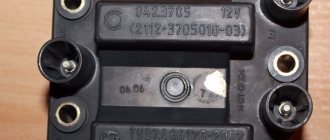Injector advantages
- more accurate fuel dosing;
- fuel burns better, engine efficiency is higher;
- gasoline costs are reduced;
- environmental pollution is reduced;
- The VAZ 2107 with an injector responds to the gas pedal much better;
- you can quickly find faults in the power system even by yourself by connecting your laptop to a “smart” injector (if the program is installed);
- For novice drivers, electronic injection is good because it does not allow the engine to stall, it decides what speed to gain, makes it easier to start without revving up, etc.;
- maintains stable idle speed, during a cold start, no “choke” is needed;
- the engine runs more quietly, as a hydraulic chain tensioner is installed;
- no valve adjustment is required, since hydraulic compensators are installed and the absence of gaps is maintained automatically;
- as a result, the injector is 15-18 horsepower more powerful;
Advantages of VAZ 2107 injection models
- Due to the optimal formation of the fuel mixture, the efficiency of an injection engine is higher than that of a carburetor. Accordingly, the VAZ 2107 injector engine consumes less fuel and is at the same time more powerful than a carburetor engine with the same volume.
- Unlike a carburetor engine, an injection engine does not require frequent adjustment of the fuel supply and ignition systems.
- The optimal composition and quantity of the fuel-air mixture entering the cylinders, as well as the presence of a catalyst, ensure a minimum content of harmful substances in the exhaust. This is an important point from an environmental and health perspective.
- Hydraulic chain tensioner and hydraulic valve clearance compensators eliminate the need for manual adjustment of the mechanism and ensure quieter engine operation.
- The torque curve is smoother - high torque is achieved over a wider rpm range.
Electronics regulate engine speed, thanks to which it idles more steadily, stalls less often when starting from a standstill, and starts better in cold weather.
Injector disadvantages
- the injector is capricious, requires regular maintenance and cleaning (otherwise the quantity and quality of injection decreases), and there is a loss of power, the engine runs unstable, and exhaust toxicity increases;
- since a new type of engine was not developed for the injector of the classics and the VAZ 2107, in particular, but “they took what they had,” then access to many parts of the traction unit is difficult, and it can be difficult to repair anything with your own hands;
- installation of the catalyst is low, below the rear axle gearbox, at a height of 10-11 cm, immediately forget about driving through a mown field to pick mushrooms;
- refuel wherever you want, but get your VAZ 2107 accustomed to excellent gasoline. Otherwise, you'll stall.
- If you stall on the injector, you will be “like on a foreign car”, you will stall for a long time. The tow truck and car service station are shining.
- When starting the engine, leave the key in the ignition position for a few seconds. This will allow the fuel pump to build up fuel pressure, otherwise it will fail.
- How much does it cost to tune a carburetor VAZ 2107 with conversion to injection injection?
- If you turn to service experts, you will spend about 30 thousand rubles on tuning. at prices in the summer of 2014, when the ruble was more or less stable for parts and labor, for everything on a turnkey basis. Maybe you'll even get a guarantee.
- If you are confident in your knowledge and experience, then, by going to auto repair shops, you can buy everything used, but working, for 12-15 thousand rubles, and disappear in the garage for a long time, doing tuning not only with your own means, but also “ with your own hands,” for this you need to be “handy” and understand hardware, but even more “big-headed” and understand electrics.
- The cost of a new six engine with an injector is 55,000 rubles. Will fit on VAZ 2107. Option with warranty. If you choose tuning at a car service center, you will receive a guarantee for both the kit and installation.
Required spare parts
If you still decide to tune the engine yourself, then here is an approximate list of parts that you need to purchase on your own:
- cylinder head with 21214;
- her gas pedal;
- MZ bracket;
- also a pulley with distributed injection;
- firmware for ECU January 5.1.1.;
- Volga fuel pump (Bosch) with bracket;
- assembled throttle with gasket, idle speed reducer;
- high-voltage ignition wires for an eight-valve engine;
- throttle cable (possible with classics);
- fuel filter for injection engine;
- highway;
- knock and speed sensors;
- receiver with ramp from 21214;
- engine cover with crankshaft position sensor;
- injection wiring harnesses;
- fuel pump and breaker plugs;
- antifreeze temperature sensor;
- air flow sensor;
- Nivovsky ignition module;
- tee with cylinder head;
..... and also all the standard gaskets and seals, which we will replace during installation.
The principle of operation of the VAZ 2107 injection engine
Unlike carburetor systems, where the preparation of the air-fuel mixture occurs in the carburetor chambers, the injection system involves injecting fuel directly into the cylinders. Therefore, such a system is called a “distributed injection system”.
Injection systems are qualified depending on the principle of operation and the number of injectors. “Seven” is equipped with a separate injection system with 4 nozzles (one per cylinder). VAZ 2107 injectors are controlled by a microcontroller of the electronic engine control unit. It regulates the flow of fuel into the cylinders depending on the operating mode, the position of the gas pedal and other parameters read by special sensors.
The ECU (electronic control unit) controls the amount of fuel and air entering the engine combustion chambers. In addition, it controls the formation of a spark on the spark plugs, changing the timing depending on the speed. The ECU also turns the fuel pump on and off, regulates idle speed, controls the amount of CO in the exhaust gases, and the temperature of the coolant in the cylinder block. It all works as follows.
Gasoline from the tank, passing through the fuel filter, is supplied by a pump to the fuel rail. The latter has a pressure regulator that regulates the flow of fuel to the injectors. A pressure of 300 MPa is maintained in the fuel rail, and excess fuel is sent to the gas tank through the return pipe.
The electronic control unit opens and closes the injectors, ensuring that gasoline is supplied to the intake manifolds with each engine revolution. The amount of fuel entering the cylinder depends on the time during which the injector is open. The ECU calculates this time based on the readings of many sensors. The main indicators that affect the injector opening time are information from the mass air flow sensor and the throttle position sensor. The opening moment of the injector is determined based on the position of the pistons in the cylinder, which is transmitted to the ECU by the crankshaft sensor.
Other parameters are also taken into account:
Sequence of work
- We drain the antifreeze below the height of the cylinder head.
- We remove the carburetor.
- Remove the intake and exhaust manifolds.
- We remove the breaker - distributor with coil.
- We remove the pulley from the crankshaft, replace the front engine cover with a new one, with space for the crankshaft sensor.
- We install a new pulley, with teeth for the sensor, not forgetting the marks.
- We install a new block head 2124. You can use a new prefabricated one, or you can use an empty one, but then you’ll have to rearrange everything with yours, or you can leave your classic one, but bore it for the new profile of the intake windows and for additional studs with your own hands;
- We install the coolant sensor on the tee of the VAZ 2107 block head, drilling a hole and cutting a thread for the sensor. Then we install it.
- After installation, we attach the intake pipes and exhaust manifold to the block head, install a ramp with injectors on the intake, and screw it on. Then you need to put on the receiver, with the throttle assembly and screw it on.
- We attach a plug to the seats of the fuel pump and breaker.
- We place the knock sensor closer to the cylinders, preferably on the breaker plug screw.
- Install the ignition module; To do this, use a grinder to level the area with your own hands ( be careful, sparks and gasoline vapors can cause a fire and explosion! ) next to the brake fluid reservoir and attach the “Nivov device.” It's away from the heat, which is better for electronics.
- We install a fine filter between the supply tube and the main line; it is easier to install it from the Volga on clamps;
- We install the return line in the same way, in the form of a second line along the bottom of the car to the tank;
- There, under the bottom, near the fastening of the speedometer and gearbox cables, we install a speed sensor;
- We put the return line into the gas tank, the main thing is to make it hermetically sealed, by drilling a hole in the intake cover and inserting the tube;
- We install a fuel pump. It is better to place it further away, as it makes noise. For example, on the wheel arch in the trunk:
- We connect the fuel pump hoses according to the diagram: intake - pump - supply line - return - pipe to the gas tank. The clamps need to be strong, otherwise there will be a stink of gasoline from the trunk into the cabin.
- Place the gas pedal, attach the gas cable to it, attach the cable to the throttle and to the receiver bracket. The cable does not need to be pulled too tight. We check the tension with our hands.
- Electrical: all new wiring, on-board computer, all fuel injection system sensors need to be installed. To discourage beginners, let’s just say that you need to not only cut out the lengths of all the circuits to the sensors, but also professionally solder them, making do with a minimum of connections to prevent “terminal souring.”
- In this case, you will have to conduct separate electrical circuits by hand: black - white, black - red, red, gray, white with a stripe, blue with a stripe, brown with a stripe of wire. They need to be carried out on the battery, fuel pump, ignition, choke light, tachometer, fan, fan relay and all sensors.
Advice: before you start purchasing all the parts and spending major financial resources, figure out which wires are connected where if you decide to install the injector yourself.
- Finally, the ignition system is installed - coil, high voltage wires.
Now the pleasant sound of an injection engine can please the owner. You have done a great job!
Replacing a carburetor with an injector - sequence of work
So, all the components have been purchased, let’s check the list one last time. After the work begins, the car will be immobilized, and it will not be possible to go to the car market for the missing element.
Using the VAZ 2109 as an example, the following set is obtained:
We photograph all the carburetor elements as they were before the alteration. Many people are interested: is it possible to reverse replace the injector with a carburetor? Of course, yes, but you probably won’t want it. It is for exceptional cases that we record everything as it was.
Advice! In such complex work, it is generally recommended to photograph each stage of the work. Then it will be easier to find the error, and it is quite difficult to maintain the system without detailed installation diagrams.
- Disconnect the battery and remove it from the engine compartment;
- We drain all technical fluids from the engine. Gasoline can be reduced to almost zero, and an unscheduled change of engine oil and antifreeze will not hurt;
- We dismantle the fuel system of the car, starting with the old gas tank. There is gasoline in the fuel lines and carburetor, so care should be taken to protect against fire;
- Carefully remove the old ignition system. There is no point in tearing off the wires - let everything remain as is;
- In place of the distributor we install a plug with a gasket;
- Let's disassemble the dashboard. If it has a “check engine” lamp, we route the control wire into the engine compartment. If not, install the indicator lamp yourself;
- We install the wiring harness for the ignition system. Each car has its own circuit, the basics are the same: power from the contact of the switched on key, signal from the tachometer;
- To connect the fuel level device, it is necessary to stretch the signal wires to the place where the fuel pump is installed in the tank. The old float no longer works, new level sensors will need to be calibrated;
- We change the oil pump, check the installation location of the crankshaft position sensor;
- We remove the old one and install a new intake manifold. We attach a fuel rail with injectors to it (in standard places);
- We install the gasoline pressure regulator in the rail, connect the fuel lines: direct, etc. "return". This is a new pipe, it was not in the carburetor system. “Excess” fuel is not removed through the injectors, but is returned back to the tank. This improves efficiency;
- We calculate the route for laying the fuel line under the bottom. We temporarily dismantle interfering elements. Important! Do not try to push the fuel line into any gap; it is better to unscrew and install the unit than to damage the high-pressure pipe;
- We prepare a new fuel tank (clean it, wash it if necessary). We install the fuel pump in accordance with the installation instructions (most containers have an arrow to orient the pipes and flanges). We install the tank on the brackets;
- We check the fixation of all elements of the fuel line. Fittings should not rotate or play;
- We install new sensors: MAF, crankshaft position, temperature;
- We install the control module (ECU) so that it does not heat up from the power unit or exhaust system;
- We connect all the braids (harnesses), check the tightness of the shrinkage of the connectors. If the new contacts did not have special technical petroleum jelly (to prevent oxidation), apply it before connecting the connectors;
- We install the throttle valve and a new throttle cable. We check and adjust the tension; there should be free play from one extreme position to the other. If your kit includes a throttle position sensor, connect it to the ECU;
- We mount a new air filter housing, having previously tried it on the throttle assembly. There should be no distortions or tension fastening;
- We assemble a standard crankcase ventilation system;
- We install the generator and carefully center the new pulley.
Fill in new oil, antifreeze and fuel. We check for leaks and perform a test start of the engine. Adjust the idle speed.
You learned how to convert a carburetor to an injector using small means. The engine is not run in; the mechanics remain the same. For the first 100-200 km, you should measure gasoline consumption and regularly check for fuel leaks and the fastening of new components.
Installing an injector on a carburetor classic
So, today we will tell you how to convert a classic carburetor engine into an injection one . We described this procedure using the example of converting a carbator VAZ-2107 into an injection one ; in principle, the instructions are suitable for any similar classic engines. In general, I decided to evolve and switch from mechanical mixture formation to electronic, simply from a carburetor to an injector . I'm tired of constantly pulling the choke handle when warming up, looking at the smoked spark plugs and the drooping tachometer needle when under load, especially in winter. No, it’s clear that building a turbo engine is much cooler than simply switching from a carburetor to an injector. But just think about how much it will cost you to repair a turbine if it fails https://turbos.com.ua/about - I think it won’t seem a little
